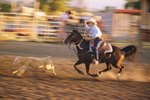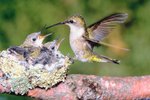
Wooing birds as beautiful as Baltimore orioles to your backyard does not require elaborate feeders. Easily constructed feeders, filled with sweet treats of oriole life, will attract the birds. Serve orioles oranges, grape jelly, dark ripe fruits or meal worms. Feeder locations, places to perch and orange colored items -- orioles love orange -- are key. For a bonus, leave orioles nesting materials, like dog hair or thin string, near feeders.
The Deli Container
Put those small, round, plastic take-out containers to good use and recycle chop sticks, too. Writer Jim Williams, nicknamed the Wing Nut, drilled two holes on opposite sides and inserted a paint brush for a perch. You can also use chop sticks for perches, since the wood is untreated. Williams filled cups with grape jelly and secured them his deck railing. Hang these feeders in trees using wire or heavy twine secured on each side of the cup.
The Feeding Cup
Find an orange tea cup and saucer at a thrift store or yard sale. Using outdoor caulk, secure the cup to its saucer. The cup should not be deep, like a mug; the birds will sit on the rim of the cup to feed. Fill the cup with grape jelly or half an orange. During breeding season, fill cups with meal worms. Cups can sit on deck railings or tables, or glue hardware to the feeder to hang it.
Plastic Building Blocks
The bloggers at Destination Nature make feeders out of children's plastic building blocks. Larger blocks are easier to glue together with strong adhesives. Create something in orange to hold orange halves, or other dark, ripe fruits like cherries, mulberries or purple grapes. Depending on the size of the creation, it can sit on a deck, or drill holes in the blocks for hanging. The Destination Nature bloggers constructed their feeder with a roof.
Kitchen Recyclables
Danni, of Silo Hill Farm in Missouri, takes her plastic containers, paints a large one orange, and then nests a smaller one inside the larger one. She holds the smaller cup in place by circling it with decorative stones. The small cup holds jelly, but can accommodate an orange half or other fruit. To keep the ants away, Danni puts water in the dish holding the cup and rocks. This feeder sits on a deck rail.
References
- Cornell Lab of Ornithology: Baltimore Oriole:
- Journey North: Oriole: Migration and Annual Cycle
- The Zen Birdfeeder: 5 Tips to Attracting Orioles into Your Yard
- Star-Tribune: Home and Garden: Wing Nut: Oriole Jelly Feeder: Homemade
- My So Called Crafty Life: DIY Teacup Bird Feeder
- Destination Nature: Make a Bird Feeder Out of Legos
- Silo Hill Farm: Make An Easy Oriole Feeder
Resources
Photo Credits
-
Jupiterimages/Photos.com/Getty Images




